
by Ray Bodrey | Nov 21, 2024
Recently Jennifer Bearden, our Agriculture & Natural Resource Agent in Okaloosa County wrote a great article on “Common Wildlife Food Plot Mistakes”. The following information is a mere supplement in establishing food plots. Planting wildlife forages has become a great interest in the Panhandle. North Florida does have its challenges with sandy soils and seasonal patterns of lengthy drought and heavy rainfall. With that said, varieties developed and adapted for our growing conditions are recommended. Forage blends are greatly suggested to increase longevity and sustainability of crops that will provide nutrition for many different species.

Hairy Vetch – Ray Bodrey
In order to be successful and have productive wildlife plots. It is recommended that you have your plot’s soil tested and apply fertilizer and lime according to soil test recommendations. Being six weeks from optimal planting, there’s no time like the present.
Below are some suggested cool season wildlife forage crops from UF/IFAS Extension. Please see the UF/IFAS EDIS publication, “A Walk on the Wild Side: 2024 Cool-Season Forage Recommendations for Wildlife Food Plots in North Florida” for specific varieties, blends and planting information. https://edis.ifas.ufl.edu/pdffiles/AG/AG13900.pdf
Winter legumes are more productive and dependable in the heavier clay soils of northwest Florida or in sandy soils that are underlain by a clay layer than in deep upland sands or sandy flatwoods. Over seeded white clover and ryegrass can grow successfully on certain flatwoods areas in northeast Florida. Alfalfa, clovers, vetch and winter pea are options of winter legumes.
Cool-season grasses generally include ryegrass and the small grains: wheat, oats, rye, and triticale (a human-made cross of wheat and rye). These grasses provide excellent winter forage and a spring seed crop which wildlife readily utilize
Brassica and forage chicory are annual crops that are highly productive and digestible and can provide forage as quickly as 40 days after seeding, depending on the species. Forage brassica crops such as turnip, swede, rape, kale and radish can be both fall- and spring-seeded. Little is known about the adaptability of forage brassicas to Florida or their acceptability as a food source for wildlife.
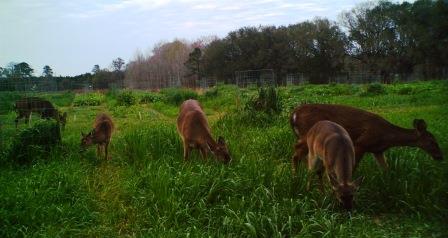
Deer taking advantage of a well maintained food plot. Photo: Mark Mauldin
For more information, contact your local county extension office.
UF/IFAS Extension is an Equal Opportunity Institution.
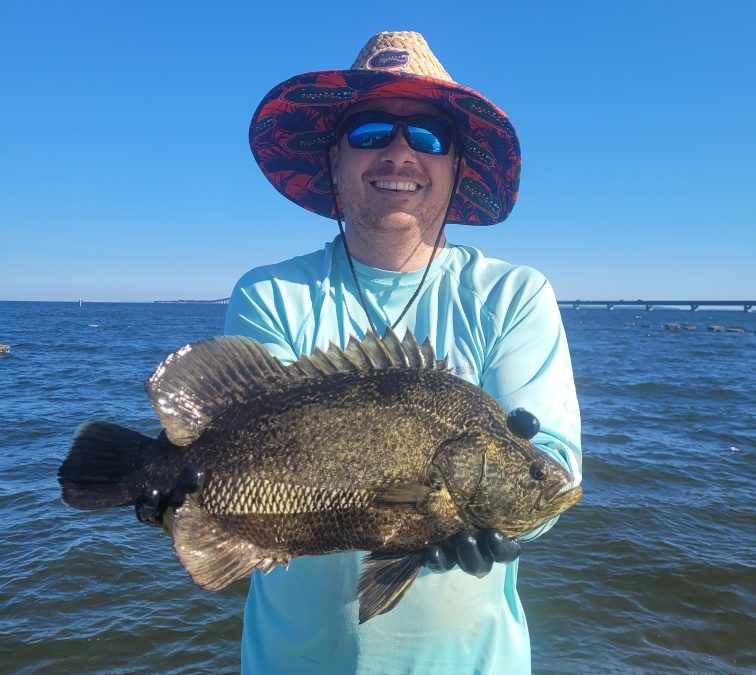
by Thomas Derbes II | Nov 8, 2024
The Atlantic Tripletail (Lobotes surinamensis) is a very prized sportfish along the Florida Panhandle. Typically caught as a “bonus” fish found along floating debris, the tripletail is a hard fighting fish and excellent table fare. Just as the name implies, this fish is equipped with three “tails” that help aid it in propulsion; and also help contribute to their strong fighting spirit. In addition to the caudal fin, tripletail have very pronounced “lobed” dorsal and anal fin soft rays that sit very far back on the body, giving it the appearance of three tails (triple-tails).
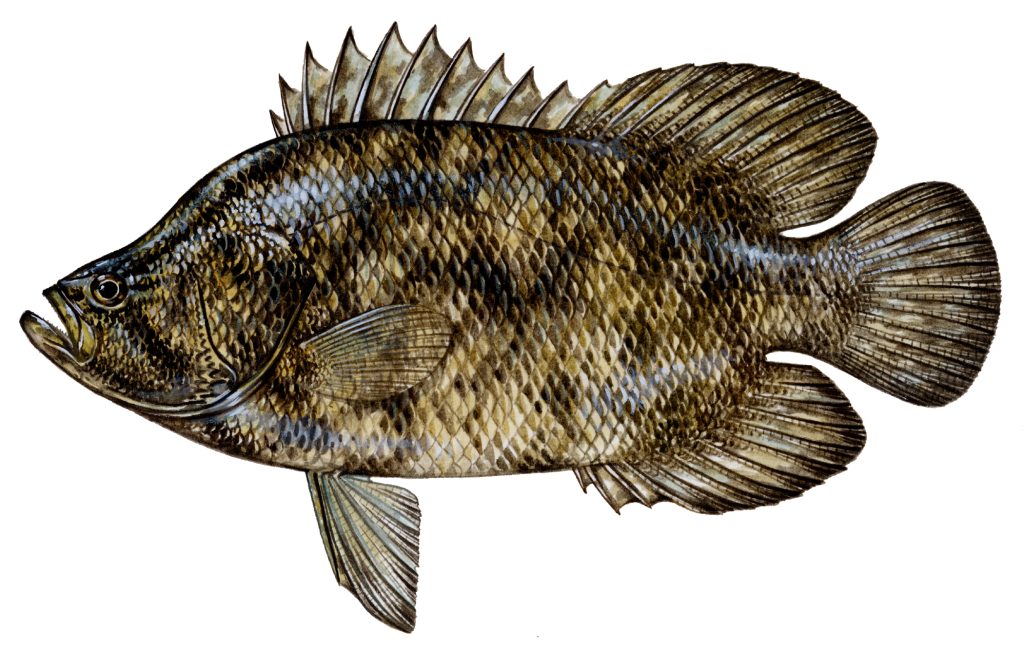
Atlantic Tripletail (Lobotes surinamensis) – FWC, Diane Rome Peebles 1992
Tripletail are found in tropical and subtropical seas around the world (except the eastern Pacific Ocean) and are the only member of their family found in the Gulf of Mexico. Tripletail can be found in all saltwater environments, from the upper bays to the middle of the Gulf of Mexico. In the Florida Panhandle, tripletail begin to show up in the bays beginning in May and can be found up until October/November. They are masters of disguise, usually found floating along floating debris, crab trap buoys, navigation pilings, and floating algae like Sargassum. When tripletail are young, they are able to change their colors to match the debris, albeit it is usually a variation of yellow, brown, and black. Adult tripletail can change color as well, but the coloration is not as vibrant as the juveniles. Floating alongside debris and other floating materials protects them from predators and gives them food access. Small crustaceans, like shrimp and crabs, and small fish will gather along the floating debris, looking for protection, giving the camouflaged tripletail an easy meal.
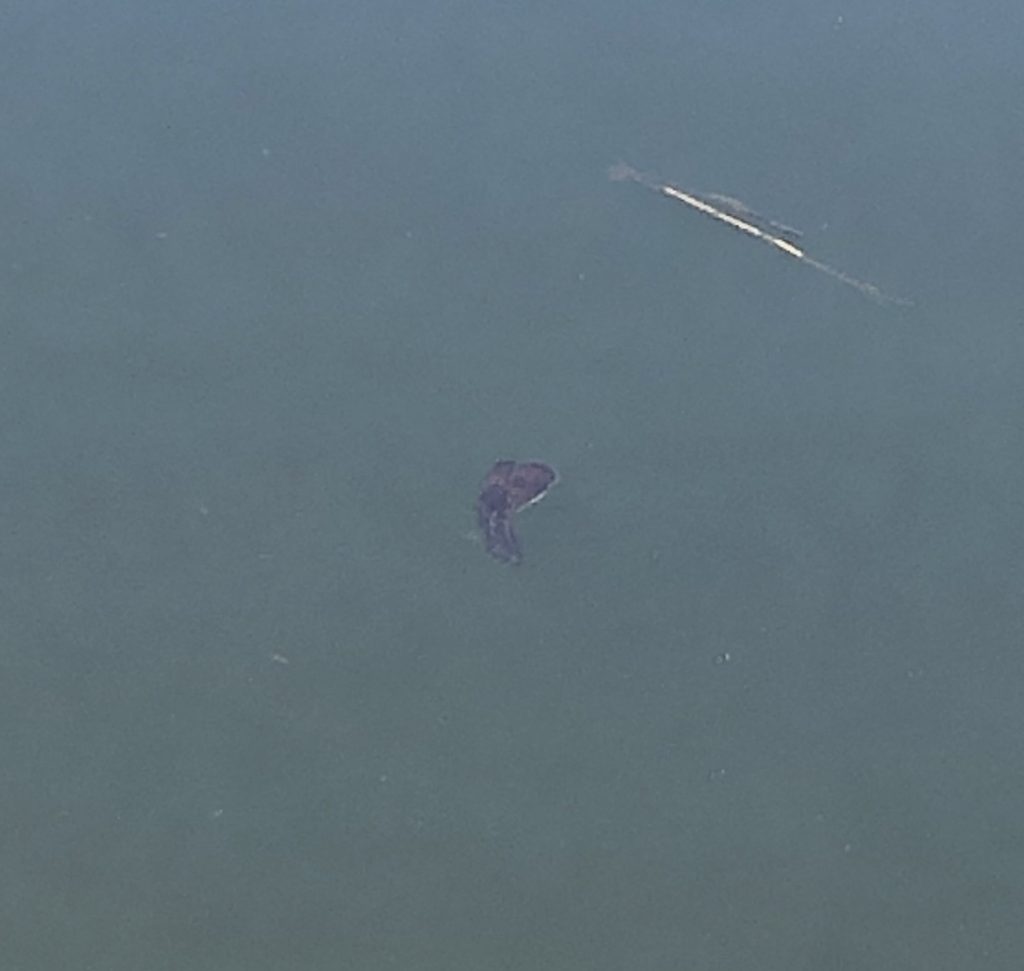
Baby Tripletail or Leaf? – Thomas Derbes II
Tripletail are opportunistic feeders that are what I classify as “lazy hunters.” Tripletail will hang out along any floating debris and wait for the food to come to them. They typically will not chase their prey items too far and will abandon the hunt if they expend too much energy. Since they are opportunistic feeders, their diet varies widely, but they cannot resist a baby blue crab, shrimp, or small baitfish like menhaden (Brevoortia patronus) that might visit their floating oasis. When further offshore, it is not uncommon to find many tripletail “laying out” on sargassum or floating debris. I personally have seen a dozen full-sized tripletail inside of a large traffic barrel 25 miles offshore that saved a skunk of a deep-dropping fishing trip.
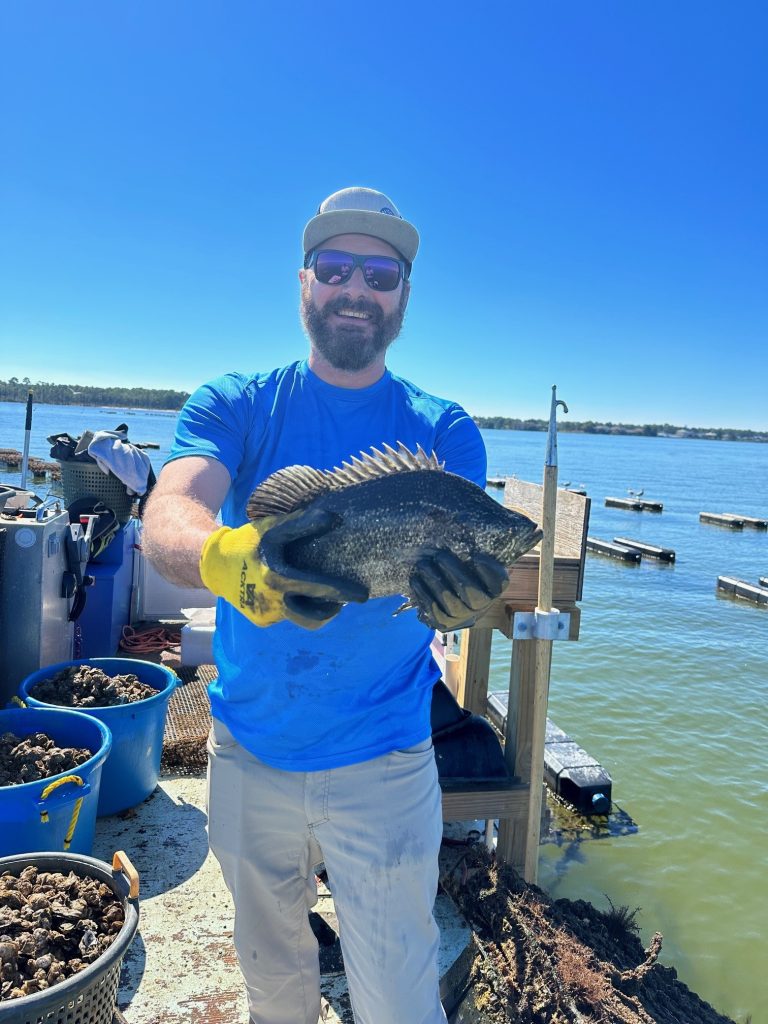
Tripletail Caught Off An Oyster Farm – Brandon Smith
When targeting tripletail, anglers will typically sit at the highest point of the boat (some anglers have towers for spotting tripletail) and cruise along floating crab trap buoys, pilings, and sometimes oyster farms looking for Tripletail. These fish are very easily spooked, and a slow, quiet approach is best. Once in casting distance, toss your preferred bait (I typically want to have baby crabs or live shrimp when targeting tripletail) close to the floating structure, but not too close to spook the fish. You can usually watch the fish eat your bait (another added bonus) and once you set the hook, the fight is on! In the state of Florida, tripletail must be a minimum of 18 inches and there is a daily bag limit of 2 fish per person. Be very careful handling tripletail as they have very sharp dorsal and anal fins and their operculum (gill cover) is also very sharp with hidden spines.
So next time you’re out fishing and see something floating, make sure you give it a good look over. There might be a camouflaged tripletail that you can add to your fish box!
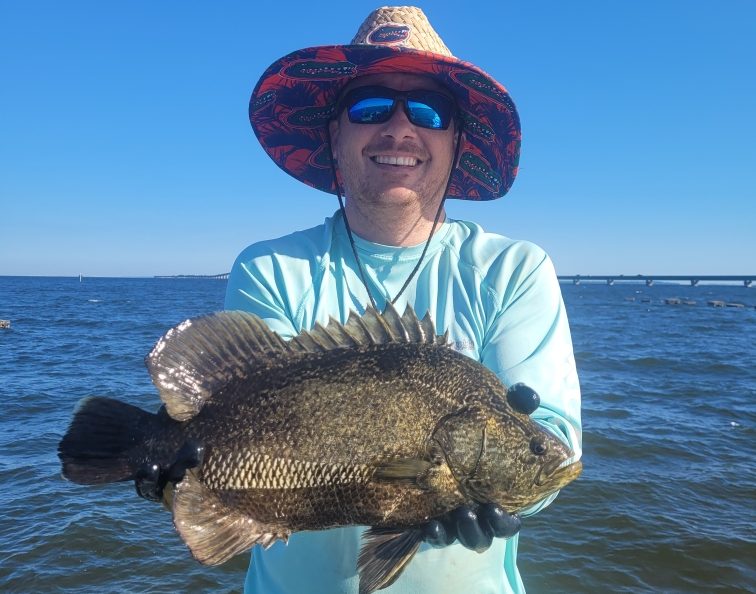
Tripletail Caught While Working Oyster Gear – Thomas Derbes
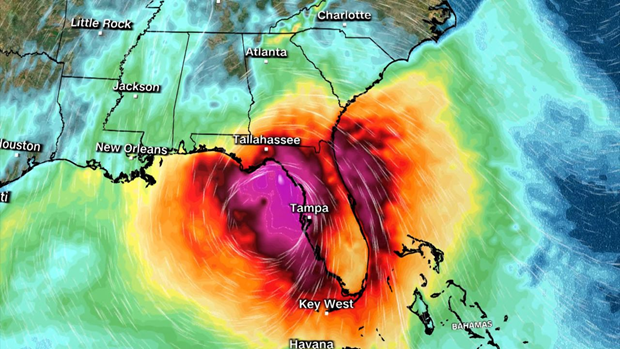
by Sheila Dunning | Oct 4, 2024
Coastal wetlands are some of the most ecologically productive environments on Earth. They support diverse plant and animal species, provide essential ecosystem services such as stormwater filtration, and act as buffers against storms. As Helene showed the Big Bend area, storm surge is devastating to these delicate ecosystems.

Hurricane Track on Wednesday evening.
As the force of rushing water erodes soil, uproots vegetation, and reshapes the landscape, critical habitats for wildlife, in and out of the water, is lost, sometimes, forever. Saltwater is forced into the freshwater wetlands. Many plants and aquatic animal species are not adapted to high salinity, and will die off. The ecosystem’s species composition can completely change in just a few short hours.
Prolonged storm surge can overwhelm even the very salt tolerant species. While wetlands are naturally adept at absorbing excess water, the salinity concentration change can lead to complete changes in soil chemistry, sediment build-up, and water oxygen levels. The biodiversity of plant and animal species will change in favor of marine species, versus freshwater species.
Coastal communities impacted by a hurricane change the view of the landscape for months, or even, years. Construction can replace many of the structures lost. Rebuilding wetlands can take hundreds of years. In the meantime, these developments remain even more vulnerable to the effects of the next storm. Apalachicola and Cedar Key are examples of the impacts of storm surge on coastal wetlands. Helene will do even more damage.
Many of the coastal cities in the Big Bend have been implementing mitigation strategies to reduce the damage. Extension agents throughout the area have utilized integrated approaches that combine natural and engineered solutions. Green Stormwater Infrastructure techniques and Living Shorelines are just two approaches being taken.
So, as we all wish them a speedy recovery, take some time to educate yourself on what could be done in all of our Panhandle coastal communities to protect our fragile wetland ecosystems. For more information go to:
https://ffl.ifas.ufl.edu/media/fflifasufledu/docs/gsi-documents/GSI-Maintenance-Manual.pdf
https://blogs.ifas.ufl.edu/news/2023/11/29/cedar-key-living-shorelines/
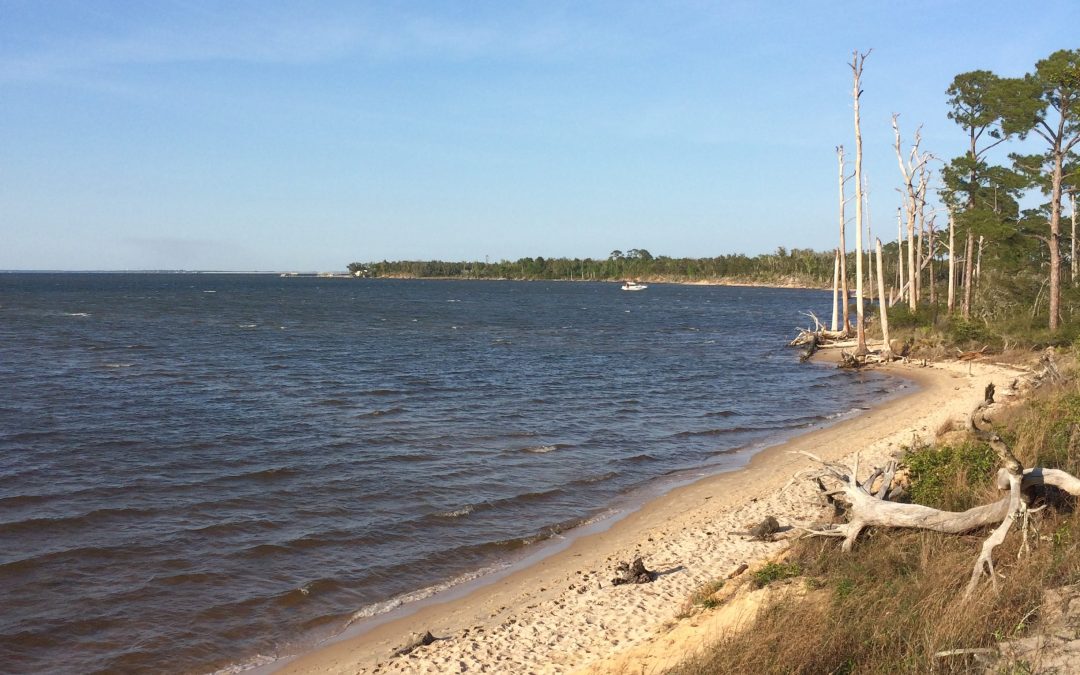
by Ian Stone | Aug 30, 2024
How are the live oak (Quercus virginiana) and the history of the United States Navy linked? That is a very interesting question that actually led to the first forest reservation and planting project in the United States. That reservation and history is still alive and well here in the Florida Panhandle, preserved still today as the Naval Live Oaks area of Gulf Islands National Seashore. In our modern times it may not register what forest and wood resources had to do with national defense but in the 1700’s and 1800’s it was key. In the times of wooden sailing ships having a Navy was key to being a Great Power. To have a powerful navy a nation had to have wood and shipbuilding resources, which meant access to forests. The abundant forest resources of North America were a driving force for colonization, especially for the British. Building the Royal Navy into the most powerful at the time required a huge amount of resources, which the American Colonies had in abundance. When our nation won its independence, it was similarly a major asset for the United States as the U.S. Navy was built. The U.S. government quickly recognized that these resource needed to be maintained and reserved, particularly the live oak which was a major wood resource with a limited supply. This led to the first forest conservation measure, which was the establishment of Naval Live Oak Reservations along the Gulf Coast in the early 1800’s.
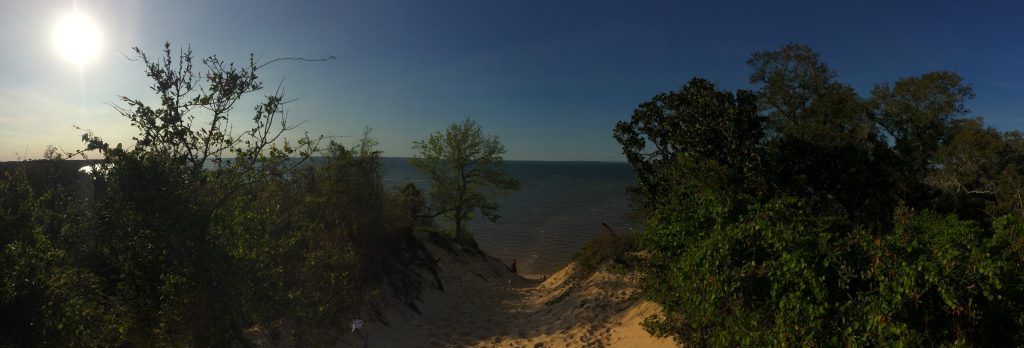
View from a high sand hill in Naval Live Oaks Gulf Breeze, FL Photo Credit: Ian Stone
Building sailing ships, required resources for the hull, masts, and waterproofing which all came from different trees and forest resources. Mast trees were in particularly high demand and usually were from particularly large and straight pines or spruce. This was a limited resource and the Eastern white pine (Pinus strobus) was a particularly good resource in North America. The southern pines were highly prized for production of naval stores which consisted of turpentine, tar, and rosin used for maintaining and waterproofing ships and their rigging. Oak was prized for hull construction, a live oak above the others. Live oak is exceeding strong and dense, one of the densest woods in North America. If you have ever experienced trying to split live oak for firewood you likely realize how hard it truly is. Axes and splitting wedges will bounce right off and barely crack a solid live oak log. It also grows in such a way that it was perfect for constructing the braces and complex hull components of ships. With these forest resources the United States had what it needed to begin building the United States Navy, a key component of national defense. In the War of 1812, the need for a strong Navy became readily apparent, and the U.S.S. Constitution would gain fame in its engagement with the Royal Navy on the open seas. U.S.S Constitution would get the nick name “Old Ironsides” from her strong live oak hull which appeared impervious to cannon shots during engagements. It is no wonder that the live oak resource was soon recognized as a critical need in expanding the Navy. President John Quincy Adams established the Naval Live Oak Reservation Program and in 1828 the Naval Live Oak Reservation was established in what is today Gulf Breeze, FL. Under the Department of the Navy a tree planting effort establishing young live oaks by planting acorns was established in the reserve. This made the Naval Live Oaks Reservation the first forestry preserve and one of the first managed forests in the United States. As with so many things it was national defense and the armed forces need for resources that lead to this program and reservation.
As live oak is a strictly North American species by the 1830’s the United States had near total control over this valuable resource. To ensure the resource was properly managed and not exhausted the Naval Live Oak Reservation system remained in place for nearly a century, with other reservations established along key areas along the Gulf and Atlantic Coasts. During this period almost all of the most significant live oak groves and resource was under Federal control for use in the building of naval ships. During the period through the civil war and just beyond this remained a critical resource for maintain Naval Power. By the start of the 20th century though wooden sailing ships had given way to steel steamers, and the live oak resource was no longer critical. In the early 1900’s many of the Naval Live Oak Reservations were returned to local governments, but the Naval Live Oaks remained in federal control. When the Gulf Islands National Seashore was created in 1971 it became part of that park under the National Park Service.
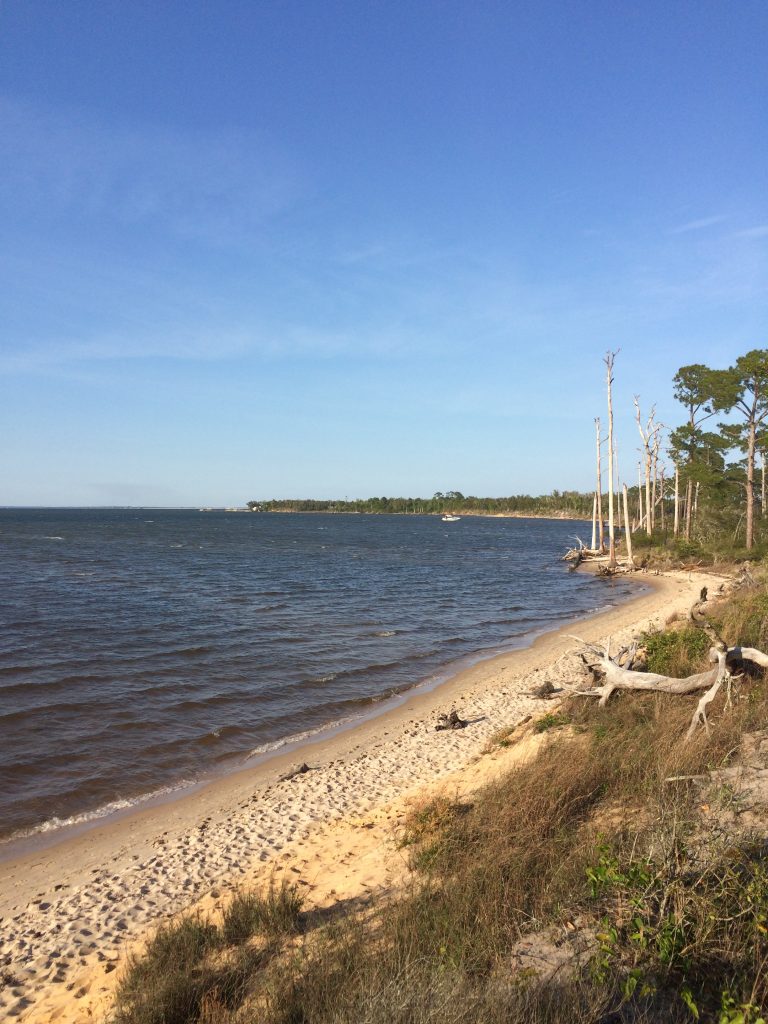
View of the Shoreline along the Naval Live Oaks Photo Credit: Ian Stone
Today you can go visit the Naval Live Oaks and experience the rich history as well as the pine and live oak forests that are part of the site. Unless you have done some history research or read some of the informational displays at the reservation the name may have been a bit puzzling. Today the forest resources at the Naval Live Oaks Reservation are not essential to our national defense. Live oak is now seldom used in lumber or other wood product applications and is largely ignored as a timber species. Today we can cherish this forest reservation for its conservation resources and the forest it preserves in an area that is heavily developed. It is a beautiful place to visit and hike, with a wonderful trail network both along the sandy hills and shorelines. You will need to have a Gulf Islands National Seashore pass as it is a fee area. It is well worth a visit to enjoy a unique forest ecosystem, which is truly unique historically. The natural beauty and habitat that the preserve covers are all due to the live oaks’ unique use in ship building during the age of sail. The live oak is a cherished and iconic tree in our region for many reasons, but when you visit the Naval Live Oaks consider the role it played in the development of the mighty United States Navy and our nation’s sea power in the era of wooden ships. While the original reason for the Naval Live Oak Reservation has past it still stands as a testament to the importance of forest resources to our nation nearly 200 years after it was founded.
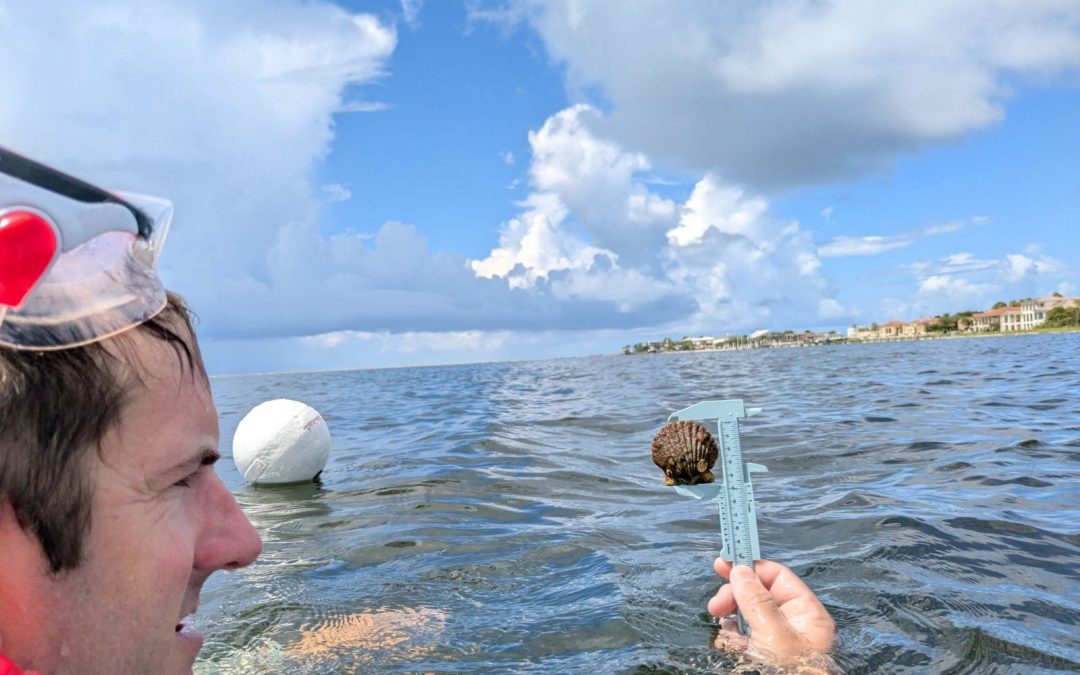
by Rick O'Connor | Aug 30, 2024
Introduction
The bay scallop (Argopecten irradians) was once common in the lower portions of the Pensacola Bay system. However, by 1970 they were all but gone. Closely associated with seagrass, especially turtle grass (Thalassia testudinum), some suggested the decline was connected to the decline of seagrass beds in this part of the bay. Decline in water quality and overharvesting by humans may have also been a contributor. It was most likely a combination of these factors.
Scalloping is a popular activity in our state. It can be done with a simple mask and snorkel, in relatively shallow water, and is very family friendly. The decline witnessed in the lower Pensacola Bay system was witnessed in other estuaries along Florida’s Gulf coast as well. Today commercial harvest is banned, and recreational harvest is restricted to specific months and to the Big Bend region of the state. With the improvements in water quality and natural seagrass restoration, it is hoped that the bay scallop may return to lower Pensacola Bay.
Since 2015 Florida Sea Grant has held the annual Pensacola Bay Scallop Search. Trained volunteers survey pre-determined grids within Big Lagoon and Santa Rosa Sound. Below is the report for both the 2024 survey and the overall results since 2015.
Methods
Scallop searchers are volunteers trained by Florida Sea Grant. Teams are made up of at least three members. Two snorkel while one is the data recorder. More than three can be on a team. Some pre-determined grids require a boat to access, others can be reached by paddle craft or on foot.
Once on site the volunteers extend a 50-meter transect line that is weighted on each end. Also attached is a white buoy to mark the end of the line. The two snorkelers survey the length of the transect, one on each side, using a 1-meter PVC pipe to determine where the area of the transect ends. This transect thus covers 100m2. The surveyors record the number of live scallops they find within this area, measure the height of the first five found in millimeters using a small caliper, which species of seagrass are within the transect, the percent coverage of the seagrass, whether macroalgae are present or not, and any other notes of interest – such as the presence of scallop shells or scallop predators (such as conchs and blue crabs). Three more transects are conducted within the grid before returning.
The Pensacola Scallop Search occurs during the month of July.
2024 Results
A record 168 volunteers surveyed 15 of the 66 1-nautical mile grids (23%) between Big Lagoon State Park and Navarre Beach. 152 transects (15,200m2) were surveyed logging 133 scallops. An additional 50 scallops were found outside the official transect for a total of 183 scallops for 2024.
2024 Big Lagoon Results
75 volunteers surveyed 7 of the 11 grids (64%) within the Big Lagoon. 67 transects were conducted covering 6,700m2.

101 scallops were logged with an additional 42 found outside the official transects. This equates to 3.02 scallops/200m2. Scallop searchers reported blue crabs and conchs, both scallop predators, as well as some sea urchins. All three species of seagrass were found (Thalassia, Halodule, and Syringodium). Seagrass densities ranged from 5-100%. Macroalgae was present in six of the seven grids (86%) but was never abundant.
2024 Santa Rosa Sound Results
93 volunteers surveyed 8 of the 55 grids (14%) in Santa Rosa Sound. 85 transects were conducted covering 8,500m2.
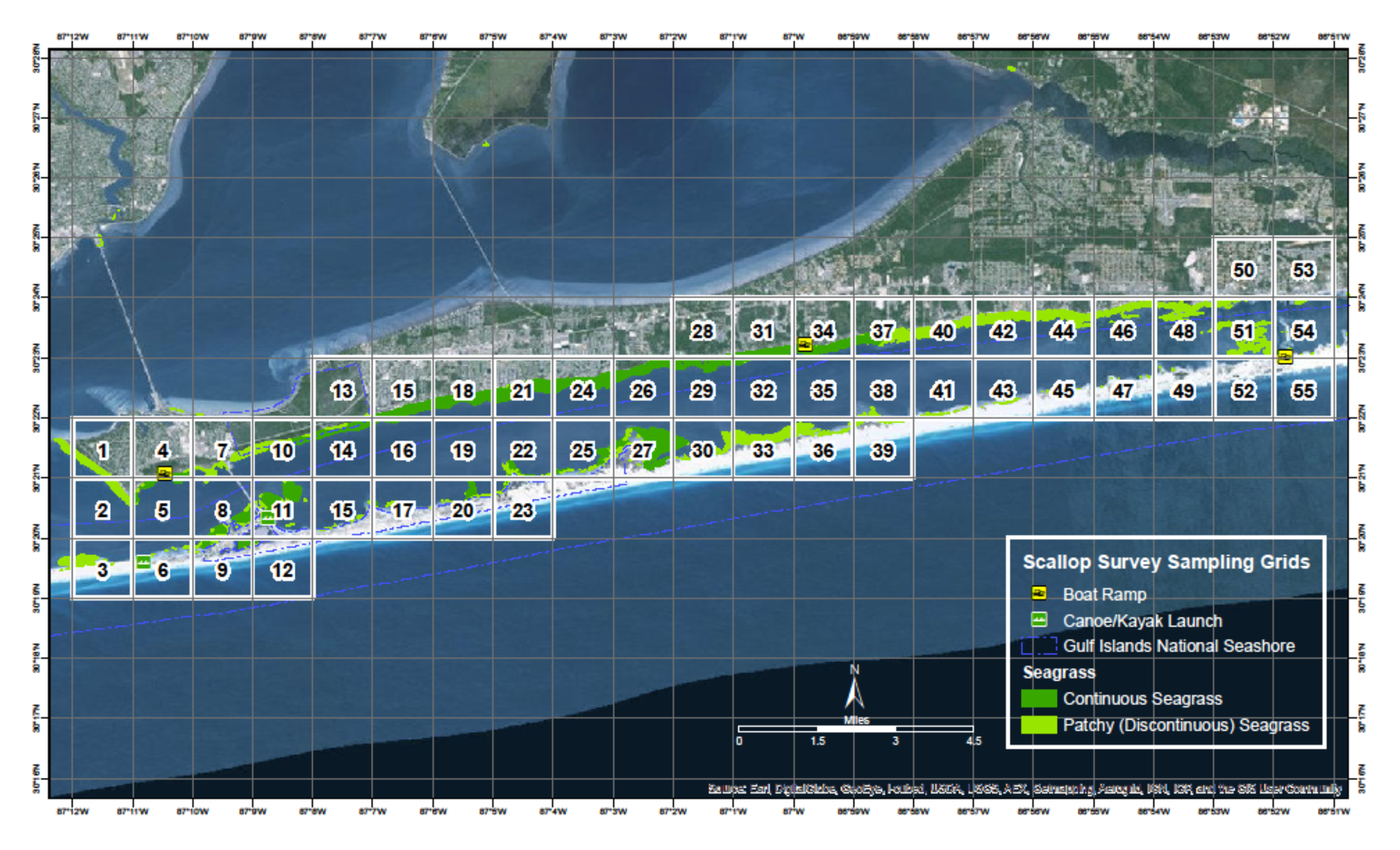
32 scallops were logged with an additional 8 found outside the official transects. This equates to 0.76 scallops/200m2. Scallop searchers reported blue crabs, conchs, and sand dollars. All three species of seagrass were found. Seagrass densities ranged from 50-100%. Macroalgae was present in five of the eight grids (62%) and was abundant in grids surveyed on the eastern end of the survey area.
2015 – 2024 Big Lagoon Results
| Year |
No. of Transects |
No. of Scallops |
Scallops/200m2 |
| 2015 |
33 |
0 |
0.00 |
| 2016 |
47 |
0 |
0.00 |
| 2017 |
16 |
0 |
0.00 |
| 2018 |
28 |
0 |
0.00 |
| 2019 |
17 |
0 |
0.00 |
| 2020 |
16 |
1 |
0.12 |
| 2021 |
18 |
0 |
0.00 |
| 2022 |
38 |
0 |
0.00 |
| 2023 |
43 |
2 |
0.09 |
| 2024 |
67 |
101 |
3.02 |
| Big Lagoon Overall |
323 |
104 |
0.64 |
2015 – 2024 Santa Rosa Sound Results
| Year |
No. of Transects |
No. of Scallops |
Scallops/200m2 |
| 2015 |
01 |
0 |
0.00 |
| 2016 |
01 |
0 |
0.00 |
| 2017 |
01 |
0 |
0.00 |
| 2018 |
01 |
0 |
0.00 |
| 2019 |
01 |
0 |
0.00 |
| 2020 |
01 |
0 |
0.00 |
| 2021 |
20 |
0 |
0.00 |
| 2022 |
40 |
2 |
0.11 |
| 2023 |
28 |
2 |
0.14 |
| 2024 |
85 |
32 |
0.76 |
| Santa Rosa Sound Overall |
1731 |
36 |
0.42 |
1 Transects were conducted during these years but data for Santa Rosa Sound was logged by an intern with the Santa Rosa County Extension Office and is currently unavailable.
Discussion
Based on a Florida Fish and Wildlife Research Institute publication in 2018, the final criteria are used to classify scallop populations in Florida.
| Scallop Population / 200m2 |
Classification |
| 0-2 |
Collapsed |
| 2-20 |
Vulnerable |
| 20-200 |
Stable |
Based on this, over the last nine years we have surveyed, the populations in lower Pensacola Bay are still collapsed. However, you will notice that in 2024 the population in Big Lagoon moved from collapsed to vulnerable for this year alone.
There are some possible explanations for this.
- The survey effort in Big Lagoon was stronger than Santa Rosa Sound. 75 volunteers surveyed 7 of the 11 grids. This equates to 11 volunteers / grid surveyed and 64% of the survey area was covered. With Santa Rosa Sound there were 93 volunteers who surveyed 8 of the 55 grids. This equates to 12 volunteers / grid surveyed but only 14% of the survey area was covered. Most of the SRS grids surveyed were in the Gulf Breeze/Pensacola Beach area. More effort east of Big Sabine may yield more scallops found.
- There is the possibility of different teams counting the same scallops. Each grid is 1-nautical mile, so the probability of one team laying their transect over an area another team did is low, but not zero.
- It is known that scallops have periodic population booms. Our search this year may have witnessed this. We will know if encounters significantly decrease in 2025.
Whether there was double counting this year or not, the frequency of encounter was much higher than in previous years. There were multiple reports from the public on social media about scallop encounters as well, and in some places we did not survey. It is also understood that scallops mass spawn. So, high density populations are required for reproductive success. The “boom” we witnessed this year suggests that there is a population of scallops – albeit a collapsed one – in our bay. It is important for locals NOT to harvest scallops from either body of water. First, it is illegal. Second, any chance of recovering this lost population will be lost if the adult population densities are not high enough for reproductive success.
Acknowledgements
We would like to thank ALL 168 volunteers who surveyed this year. We obviously could not have done this without you.
Below are the “team captains”.
Harbor Amiss Glen Grant Eric Stone
David Anderson Phil Harter Neil Tucker
Laura Baker Gina Hertz Christian Wagley
Melinda Bennett Sean Hickey Jaden Wielhouwer
Samantha Bergeron (USM class) John Imhof Keith Wilkins
Cheri Bone Jason Mellos Christy Woodring
Cindi Cagle Greg Patterson
Cher Clary Kelly Rysula

A team of scallop searchers celebrates after finding a few scallops in Pensacola Bay.
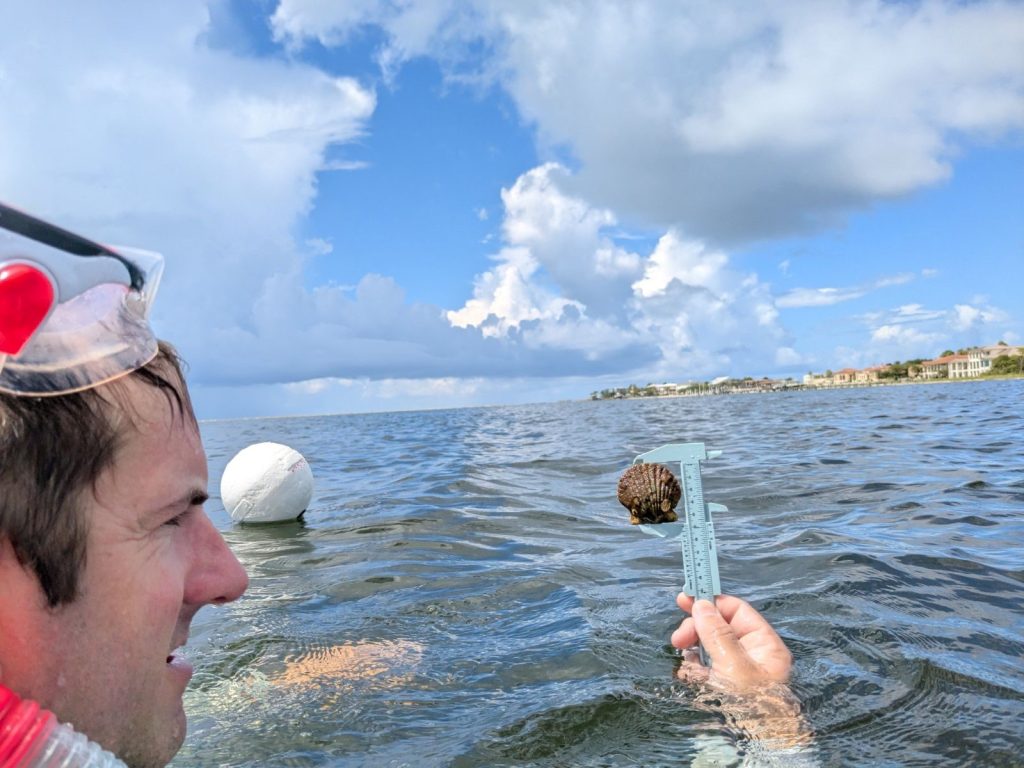
Volunteer measures a scallop he found. Photo: Abby Nonnenmacher
Rick O’Connor Florida Sea Grant; Escambia County
Thomas Derbes II Florida Sea Grant; Santa Rosa County
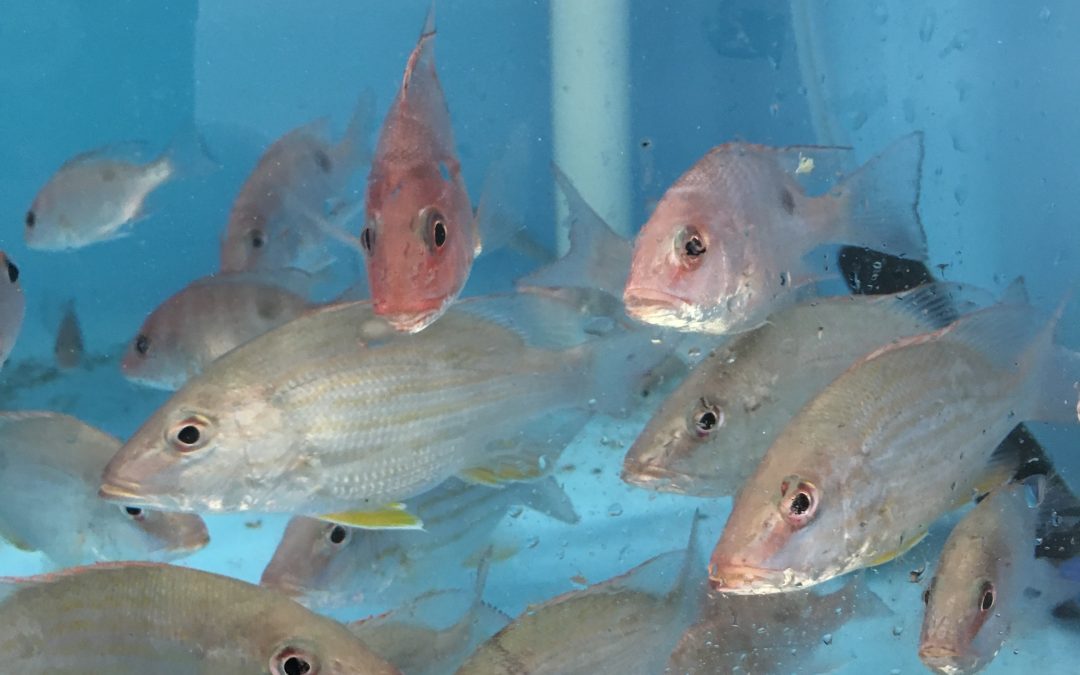
by Thomas Derbes II | Aug 10, 2024
Many of us are given that Birds and the Bees talk; another majority have had to give it as an adult to their kids. It is usually an awkward talk, but someone had to step up to the plate and put on a straight face. I am happy to be the one today to discuss one section of the Birds and the Bees of the Sea, batch spawning. Batch spawning, also known as broadcast spawning, is the coordinated release of gametes (sperm and eggs) into the water column. Batch spawning is not just relegated to fish, many species of invertebrates also batch spawn. Some of the most commonly encountered batch spawners include Florida Pompano (Trachinotus carolinus), Eastern Oyster (Crassostrea virginica), Red Drum (Sciaenops ocellatus), Red Snapper (Lutjanus campechanus), and Gag Grouper (Mycteroperca microlepis), to name a few. In fact, most gamefish species in the Gulf of Mexico are batch spawners. This has its advantages, but also has its major disadvantages. We will dive headfirst into a few representative species of saltwater organisms that batch spawn, and their respective life stages to help shed some light on reproduction in the marine world.
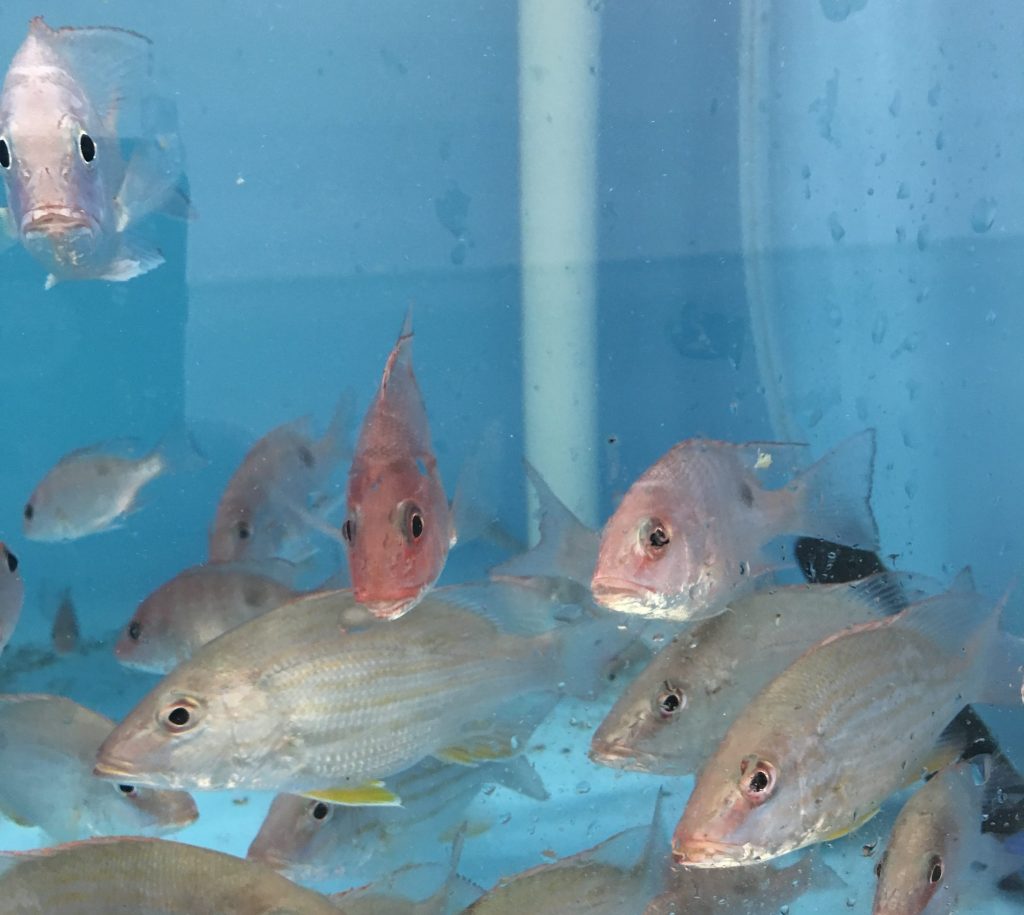
Baby Snapper – Thomas Derbes II
Eastern Oysters are a perfect representative for invertebrate batch spawning. I have gone over their life cycle in a previous article (Click Here), but I will just quickly go over their spawning habits and life history. Eastern Oysters typically spawn during the changing of the seasons, particularly from Spring to Summer and Summer to Fall. As humans, we see these changing temperatures and weather fronts as an opportunity for a new wardrobe, but these changes are triggers for oysters to spawn. Once one oyster releases their gametes into the water all of the mature oysters in the area will start releasing their gametes. Waiting to sense for other gametes in the water is a very smart tactic. This allows for a coordinated spawn between masses of oysters and (hopefully) increases the fertilization rate of the eggs. Since oysters cannot move, batch spawning is the most beneficial way for them to reproduce. Females can release anywhere from 2 to 70 million eggs in one spawning event, with only a dozen or so becoming adults. Since they are batch spawners, the larvae are left unprotected by the parents and suspended in the water column for the first few weeks, leaving them susceptible to predation by filter feeders and bad water quality. Once the larvae have reached the pediveliger stage, they will settle out and “walk” along the bottom of the estuary until they find a suitable place to call home, usually another oyster or hard substrate. After 1-3 years, the oyster will mature and begin batch spawning when conditions are ripe, and the cycle continues!
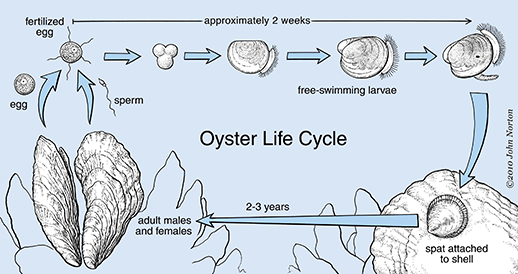
The Oyster Life Cycle – Maryland Sea Grant
Fish in the Lutjanidae (snapper) family are the perfect representative for batch spawning with fish. Snappers of all species are known to congregate and have mass spawning events typically around a full moon. The mutton snapper (Lutjanus analis) of South Florida and the Florida Keys are very well known for their ability to form massive congregations of tens of thousands of fish along the reef starting in April. Once the spawning commences, the mutton snapper will form a small subgroup of up to 20 fish in the late afternoon. This subgroup will travel to depths of up to 100ft to perform their spawning event. During this event, the female will signal to the males that she is about to release her eggs. The males will then rub up against the side of the female snapper, helping her release eggs while simultaneously releasing their milt (sperm). When the milt is released, the sperm is activated by the seawater and begins to swim. Eventually, the eggs are fertilized and an embryo is formed.

Massive Two-spot red snapper aggregation ready to spawn in Palau – R.J. Hamilton
18 – 24 hours later, the embryo is now a larval fish consisting of a yolk sac and lacking a mouth, eyes, and most organs. The yolk sac consists of amino acids and other nutrients that provide energy to the developing larvae. These larval fish have until their yolk sac runs out to develop the lacking vital organs, which usually takes between 24 – 48 hours. Only a very small percent of juvenile snapper make it to adulthood due to predation during their larval stage and predation as a juvenile. In fact, sharks and other large predators will prey on the snapper as they congregate and spawn, and filter feeders like manta rays are known to pass through an active spawning congregation to consume all the fertilized eggs and larval fish.
Well, I hope I didn’t scar anyone too badly. Batch spawning is fairly common in the marine biology world, and you can sometimes experience a spawning event without even knowing it. As for positives, this allows for many eggs to be fertilized at a time multiple times a season and for the larval fish and shellfish to be distributed through the estuary and reef via tides and waves. A major negative is the vulnerability of the juvenile and larval fish and shellfish, but the sheer number of eggs produced and fertilized helps outweigh the high potential for predation and unexplained loss of fertilized eggs and juveniles.
References:
Oyster Spawning: https://www.umces.edu/news/the-life-of-an-oyster-spawning
Mutton Snapper Species Spawning Profile: https://geo.gcoos.org/restore/species_profiles/Mutton%20Snapper/
Mutton Snapper Aquaculture Profile: https://srac.msstate.edu/pdfs/Fact%20Sheets/725%20Species%20Profile-%20Mutton%20Snapper.pdf




















